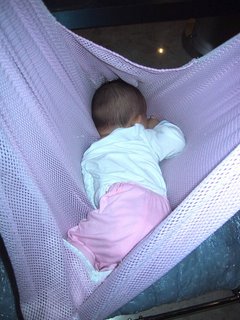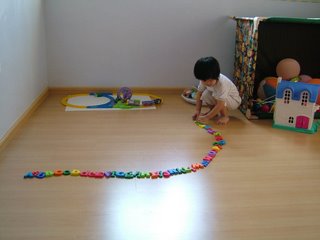"Salong" game
I was looking at 慧's old pictures yesterday, when she was still a little baby, and noticed some of her "salong" pics.
Yes, 慧 slept in a "salong" when she was little, for under a year. A mechanically automated one too! Without my niece, I would never have known how hi-tech some of these baby related stuff have become. The "salong" is just one such example. Compared with the "salong" of old, the material is now thinner and has holes on it, thereby allowing it to breathe (see pic below). And as I've mentioned, it rocks automatically. There is now an engine attached at the top that pulls and releases the "salong", giving the same comfortable up and down movement of old. My bro-in-law joked that he used to use his foot to rock the "salong" of a nephew when he was a boy. "Just look at what we have now." I have to say I am an advocate for the "salong", manual or automatic. I believe this is Asia's solution to cot death. The most dangerous period for a baby, with respect to cot death, is just after it has learnt to turn over. That's usually when it is about 2-3 months old, when they are strong enough to turn over, feel really elated about it for a while, but don't have the strength to turn back. And when their heads get tired, tragedy strikes... that's how cot death happens (in my opinion). Only difference between regular turning over and cot death is this turning over is done when the baby is asleep.
I have to say I am an advocate for the "salong", manual or automatic. I believe this is Asia's solution to cot death. The most dangerous period for a baby, with respect to cot death, is just after it has learnt to turn over. That's usually when it is about 2-3 months old, when they are strong enough to turn over, feel really elated about it for a while, but don't have the strength to turn back. And when their heads get tired, tragedy strikes... that's how cot death happens (in my opinion). Only difference between regular turning over and cot death is this turning over is done when the baby is asleep.
But with a "salong", cot death simply can't happen. For one, the material breathes. More importantly, the design of the "salong" makes it difficult for the baby to turn over. Although my niece managed it from time to time, it was only after she was much older and stronger. I used to watch my niece closely when she was 2-3 months old and lying on a bed. I would allow her to turn over but once she tired, she would struggle a little and I would have help her turn back. Then she'll take a break and start the turning over process again.
I used to watch my niece closely when she was 2-3 months old and lying on a bed. I would allow her to turn over but once she tired, she would struggle a little and I would have help her turn back. Then she'll take a break and start the turning over process again. Then I recall a silly game I used to play with 慧. We used to place her "salong" in the living room so that it was easy to check on her. 慧 had this habit of self-entertainment for about half an hour or so after waking up from her naps. You knew she was awake because the "salong" would be swaying side to side (we would switch the engine off once she's sound asleep) and her hands and legs were all over the place.
Then I recall a silly game I used to play with 慧. We used to place her "salong" in the living room so that it was easy to check on her. 慧 had this habit of self-entertainment for about half an hour or so after waking up from her naps. You knew she was awake because the "salong" would be swaying side to side (we would switch the engine off once she's sound asleep) and her hands and legs were all over the place. And when I was free, I would sneak up next to her "salong" but remain out of her line of sight. She'd know someone is around and made little noises in response. I would then peek slowly over and into the "salong". Once she sees me, she'd let out squeals of laughter. I managed to capture one such magical moment with my sis's digital cam.
And when I was free, I would sneak up next to her "salong" but remain out of her line of sight. She'd know someone is around and made little noises in response. I would then peek slowly over and into the "salong". Once she sees me, she'd let out squeals of laughter. I managed to capture one such magical moment with my sis's digital cam.
 163 days to go.
163 days to go.
Yes, 慧 slept in a "salong" when she was little, for under a year. A mechanically automated one too! Without my niece, I would never have known how hi-tech some of these baby related stuff have become. The "salong" is just one such example. Compared with the "salong" of old, the material is now thinner and has holes on it, thereby allowing it to breathe (see pic below). And as I've mentioned, it rocks automatically. There is now an engine attached at the top that pulls and releases the "salong", giving the same comfortable up and down movement of old. My bro-in-law joked that he used to use his foot to rock the "salong" of a nephew when he was a boy. "Just look at what we have now."
 I have to say I am an advocate for the "salong", manual or automatic. I believe this is Asia's solution to cot death. The most dangerous period for a baby, with respect to cot death, is just after it has learnt to turn over. That's usually when it is about 2-3 months old, when they are strong enough to turn over, feel really elated about it for a while, but don't have the strength to turn back. And when their heads get tired, tragedy strikes... that's how cot death happens (in my opinion). Only difference between regular turning over and cot death is this turning over is done when the baby is asleep.
I have to say I am an advocate for the "salong", manual or automatic. I believe this is Asia's solution to cot death. The most dangerous period for a baby, with respect to cot death, is just after it has learnt to turn over. That's usually when it is about 2-3 months old, when they are strong enough to turn over, feel really elated about it for a while, but don't have the strength to turn back. And when their heads get tired, tragedy strikes... that's how cot death happens (in my opinion). Only difference between regular turning over and cot death is this turning over is done when the baby is asleep.But with a "salong", cot death simply can't happen. For one, the material breathes. More importantly, the design of the "salong" makes it difficult for the baby to turn over. Although my niece managed it from time to time, it was only after she was much older and stronger.
 I used to watch my niece closely when she was 2-3 months old and lying on a bed. I would allow her to turn over but once she tired, she would struggle a little and I would have help her turn back. Then she'll take a break and start the turning over process again.
I used to watch my niece closely when she was 2-3 months old and lying on a bed. I would allow her to turn over but once she tired, she would struggle a little and I would have help her turn back. Then she'll take a break and start the turning over process again. Then I recall a silly game I used to play with 慧. We used to place her "salong" in the living room so that it was easy to check on her. 慧 had this habit of self-entertainment for about half an hour or so after waking up from her naps. You knew she was awake because the "salong" would be swaying side to side (we would switch the engine off once she's sound asleep) and her hands and legs were all over the place.
Then I recall a silly game I used to play with 慧. We used to place her "salong" in the living room so that it was easy to check on her. 慧 had this habit of self-entertainment for about half an hour or so after waking up from her naps. You knew she was awake because the "salong" would be swaying side to side (we would switch the engine off once she's sound asleep) and her hands and legs were all over the place. And when I was free, I would sneak up next to her "salong" but remain out of her line of sight. She'd know someone is around and made little noises in response. I would then peek slowly over and into the "salong". Once she sees me, she'd let out squeals of laughter. I managed to capture one such magical moment with my sis's digital cam.
And when I was free, I would sneak up next to her "salong" but remain out of her line of sight. She'd know someone is around and made little noises in response. I would then peek slowly over and into the "salong". Once she sees me, she'd let out squeals of laughter. I managed to capture one such magical moment with my sis's digital cam. 163 days to go.
163 days to go.


0 Comments:
Post a Comment
<< Home